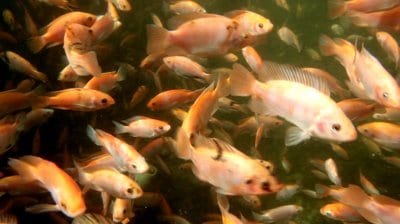Asian Fish Farmers Benefit from IPRS
- Category:
- Aquaculture

The In-Pond Raceway System (IPRS) got its genesis from the collaboration between USSEC and Auburn University in early 2007, with the objective to integrate traditional pond aquaculture production and the raceway aquaculture system. The system aimed to improve the efficiency in catfish production with improved survival and production rates.
In 2013, the system was established at Pingwang Fish Farm of the Wujiang Municipal Aquaculture Co., Ltd., Suzhou City, Jiangzu province, China. The objective of the first IPRS demonstration in China was to address the increasing demand for aquaculture products in that country. That first demonstration in China was very successful. The total yield after the system was installed was 42 metric tons (MT) of grass carp from a 2.1 ha pond unit containing three IPRS cells. This represented nearly three times the average pond yield of 7.2 MT/Ha.
The success of this system can help other countries, which USSEC already proven in Vietnam. In that country, farmers have successfully increased their productivity by installing the IPRS system. This was demonstrated during USSEC’s visit to Vietnam’s IPRS system and the farmers using it, Mr. Le Van Viet of Gia Loc District, Hai Duong Province, and Mr. Vu Duy Hao and Mrs. Vu Thi Tham, both of My Hao District, Hung Yen Province.
The IPRS systems in China and Vietnam can increase biomass output by as much as 200 percent with no extra water or pond area required. Better water quality leads to less disease. The fast water flow and higher dissolved oxygen raises survival rate to as high as 95 percent. Fewer chemicals are used for the culture in comparison to the traditional pond culture. Feed intake and assimilation also improved.
The benefits of the IPRS system can be summarized as follows:
This technology can be transferred to Thailand to increase the productivity of freshwater fish there. The target is for Thai fish farmers to visit the IPRS system in Vietnam and learn the technology to install the system in Thailand. This will increase fish production in Thailand with sustainable yields and a sustainable environment.
